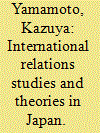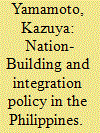| Srl | Item |
| 1 |
ID:
103997


|
|
|
|
|
| Publication |
2011.
|
| Summary/Abstract |
A common view of Japan's International Relations (IR) studies in the post-World War II period is that they are characterized by pacifism and historical approaches. This paper argues that while pacifism has continued to serve as the basis of them, the approaches adopted by researchers have become increasingly diversified. Specifically, although the main issues for Japanese IR studies in the postwar period (i.e. defense strategy, world political economy, and global issues) have been consistently addressed by researchers on the basis of pacifism, the theoretical orientation of researchers has continually become stronger. Finally, this paper argues that both changing and continuous characteristics of IR studies in Japan have been supported by global developments, and concludes that this trend will continue into the near future.
|
|
|
|
|
|
|
|
|
|
|
|
|
|
|
|
| 2 |
ID:
076878


|
|
|
|
|
| Publication |
2007.
|
| Summary/Abstract |
The Philippines can be considered a country where successive governments have sought to create a single nation by implementing integration policies. In this article, two formal models are developed -the modernism model and the historicism (primordialism or essentialism) model - to suitably analyze the national integration policy of the Philippines. The analysis reveals that (1) the post-independence national integration policy of the Philippines cannot be regarded as being successful; (2) national integration in the Philippines will continue to be difficult; (3) no deterministic argument can be made regarding the relationship between mobilization and national cleavage; and (4) the modern nation should not be regarded as an extension of pre-modern ethnic groups but as a new identity group that is formed through the process of modernization. In addition, the mathematical implications of the two models are derived. The modernism model implies that (1) in some cases, a ruling group that is in the majority at the time of independence can maintain its position even if it cannot assimilate a majority of the underlying people after independence; (2) in some cases, a ruling group that is not in the majority at the time of independence cannot attain a majority even if it is able to assimilate a majority of the underlying people after independence; and (3) a larger ruling group is not always capable of promoting greater integration than a smaller one can. On the other hand, the historicism model implies that the size of the underlying ethnic group that will comprise the ruling group when mobilized is the key to the success or failure of national integration.
|
|
|
|
|
|
|
|
|
|
|
|
|
|
|
|